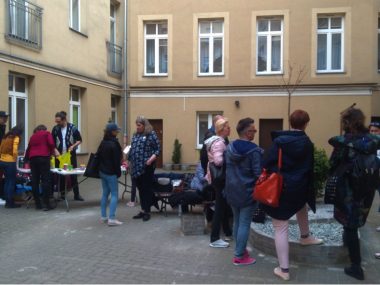The Local Pact
Edited on
10 July 2020A reinforced approach for tackling urban poverty.

A policy paper calling for implementation of a renewed approach to tackling urban poverty based on a ‘Local Pact’ is the core output of work delivered by URBACT for the Urban Poverty Partnership (UPP) of the Urban Agenda for the EU. Here, we present the key elements of the proposed approach and the paper’s messages for the development of future policies addressing urban poverty across Europe.
Citizen participation at the centre of the revitalisation efforts in Łódź (PL), URBACT Regeneration Mix network
Seven dimensions of a reinforced policy approach
A manifesto within the policy paper calls for the Local Pact as a new and reinforced approach to tackling urban poverty. This approach combines area-based regeneration (prioritising public interventions in neighbourhoods with the most socio-economic difficulties) together with a clear commitment to more participatory co-creation processes with local stakeholders (based on an extended model of public-private-community partnerships).
The Local Pact approach comprises at least seven different aspects:
- Area-based policy – to reinforce (technically and financially) public interventions in priority areas which experience the most socio-economic difficulties.
- Integrated urban development – to deliver ambitious local strategies and action plans combining physical and soft interventions.
- Multi-level governance (finance) – to concentrate and optimise funds from all territorial levels (European, national, regional, local) and all sources (public and private).
- Co-creation and social innovation – to encourage and empower local inhabitants to become active stakeholders in the transformation of their area and the implementation of new solutions.
- Multi-level governance (strategies) – to encourage and support urban authorities to implement strategies at the local level according to a common national/regional framework.
- Horizontal cooperation (governance) – to ensure active participation from all municipality departments, all sectors and all type of stakeholders in local governance bodies.
- Capacity building – enhancing human resources and mobilising local stakeholders to increase capacities to plan, implement, monitor and evaluate actions.
A call to action at all levels
This reinforced approach for tackling urban poverty has clear implications for decision-making at local, national and European levels. At the local level, the approach calls on municipalities to co-build new solutions with local inhabitants, public institutions, knowledge organisations and the private sector.
At the national level, the concept of the Local Pact can stimulate countries to allocate at least 6% of their European Regional Development Fund (ERDF) resources to sustainable urban development (Article 9 of the proposed post-2020 ERDF regulation) and more specifically to priority urban areas.
Finally, at European level, this approach offers a useful basis for reflection on the next Cohesion Policy and how the different European Structural Funds can be effectively harnessed to support local strategies targeting priority urban districts. It can also positively contribute to the updating of the Leipzig Charter on sustainable European cities and to the implementation the UN Sustainable Development Goals.
Or why not be even bolder and deliver a specific new European territorial instrument to encourage and support local authorities to apply the Local Pact policy approach in deprived urban areas? Such a ‘Local Integrated Pact’ (LIP) instrument would be multi-fund, flexible, integrated and largely based on ideas of local stakeholders, within the framework of the future Cohesion Policy and its future policy objective 5.

Priority area in France, in the context of the ‘Politique de la Ville’
Learning from four country examples
The policy paper was built on work carried out by URBACT at the request of the UPP. URBACT was asked to take forward the UPP proposal for “the Local Pact as a multi-fund instrument… in the Cohesion Policy post-2020,” providing a potential tool for urban authorities to focus interventions on areas most impacted by poverty.
In that context, URBACT organised a set of three policy labs during the course of 2018 to examine the models and examples of four countries: France, Germany, Poland and Spain. The labs brought together representatives of national, regional and local levels to analyse their urban policies targeting deprived areas.
The labs identified important differences in approach to tackling urban poverty reflecting specific national contexts. This was seen notably in terms of the administrative framework in place and the extent to which decision-making is centralised or devolved, the relative importance of European funds – in particular the European Regional Development Fund (ERDF) and European Social Fund (ESF) – for supporting targeted urban policies, and the culture and experience of citizen participation thus far.
The labs also identified important differences in approach reflecting specific local contexts. For example, whether the most deprived urban areas are in the historical centre or the suburbs of a city leads to quite different intervention policies. In the first case, the challenge is typically more about how to improve quality of life without causing gentrification, whilst in the latter, the challenge is typically about avoiding ‘ghettoisation’ and promoting social diversity.
Three URBACT policy labs Three URBACT policy labs on tackling urban poverty were held in Saint-Denis (FR), Lodz (PL) and Barcelona (ES). They involved national, regional and local-level stakeholders from four participating countries: - France: City of Lille (local level); Metropolitan area of Lille (inter-municipal level); CGET (national level). - Germany: City of Berlin (local level); Senate Department for Urban Development and Housing, Section Soziale Stadt (regional level); Federal Institute for Research on Building, Urban Affairs and Spatial Development (national level). - Poland: City of Łódź (local level); Marshall office (regional level); and Ministry of Investment and development, Urban policy unit (national level). - Spain: City of Barcelona (local level); Region of Catalunya (regional level); and Ministry of Development, Urban Policies Deputy Directorate (national level). |
Guidelines on core aspects of the Local Pact approach
To support urban policymaking, the paper provides an overview of how to put into practice different elements of the desired approach, with particular reference to the examples provided by France, Germany, Poland and Spain.
These ‘guidelines’ cover: multi-level governance; an integrated approach; participation; financial management of area-based policies; institutional management and technical support; and monitoring and evaluation. Under each heading, the document sets out some of the key challenges to be overcome, important aspects of the approach to be implemented and practical examples from the four countries examined.
For example, under ‘participation’, the paper identifies that the main challenge is to develop active participation of citizens from priority districts. This involves making skills and resources available to engage residents with a large diversity of profiles in genuine co-design and co-implementation of local urban policies. The guidelines address the examples of Citizens Councils used in France, and Neighbourhood Councils and Action Fund Juries in Germany.
Under ‘integrated approach’, the paper highlights the main challenges as being to ensure a multi-sectoral intervention in priority districts taking into account social, environmental, economic and physical aspects. This involves combining physical interventions with soft measures (social support), and effective horizontal cooperation between different administrative departments. The examples presented include the use of ‘City Contracts’ covering social cohesion, liveability and economic development in France, and the ‘Social City’ programme in Germany.
A final call to action!
The URBACT policy paper on tackling urban poverty argues that much could be achieved if a growing number of countries would commit by applying the suggested multi-level governance model for urban policy, targeting priority areas. In any case, as we move into the next EU programming cycle, it will be important that significant funding and adequate instruments are in place to target the most deprived areas. Let us together be bold!
-

The Local Pact policy paper is available here.
To read the country profiles, click on the relevant links for France, Germany, Poland and Spain.
The full version is available
 Submitted by Séverine BRESSAUD on
Submitted by Séverine BRESSAUD on




